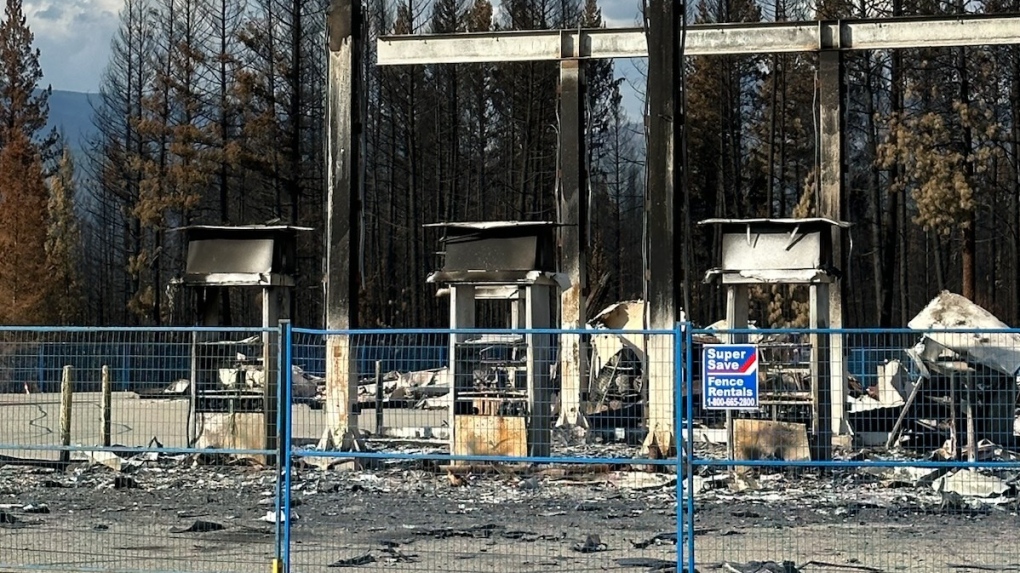SCOTCH CREEK, B.C. –
Twisted metal, charred debris and endless ash are all that remains of the Scotch Creek-Lee Creek Fire Hall.
The building, which stood for years in the Shuswap region of British Columbia, was destroyed after a fast-moving wildfire ripped through the area last month.
“It’s important to emphasize that the area is very different now,” said Derek Sutherland, the director of emergency operations for the Columbia Shuswap Regional District. “The fire zone is still extremely dangerous due to significant damage and dangerous conditions.”
The Bush Creek East wildfire exploded in size on Aug. 18, and according to B.C Wildfire Service, it grew nearly 20 kilometres in 12 hours, which is among the fastest growth for a wildfire ever recorded.
In its wake, the fire left a devastating path of destruction. The Columbia Shuswap Regional District (CSRD) said 176 structures have been deemed a total loss as of Monday.
“It was terrifying,” said Brian Dalgleish, captain of the Scotch Creek-Lee Creek Fire Hall. ” We saw the wall of flames coming, but we had no choice to back down and we couldn’t save the hall even though we tried.”
Steps away from the former fire department, there is another heap of blackened rubble, which was once a popular community hall. On its website, the regional district describes the facility as a place for “weddings, family gatherings and celebrations.” However, the beloved building is now unrecognizable.
The wildfire not only burned businesses and homes in the CSRD, but also decimated neighbouring communities. In the nearby Thompson-Nicola Regional District, nine structures were levelled and 85 were lost on the territory of the Skwlax te Secwepemculecw First Nation, which amounts to roughly one-third of all properties.
 The Scotch Creek-Lee Creek fire department building was one of nearly 200 structures completely destroyed by wildfire. (Melanie Nagy)
The Scotch Creek-Lee Creek fire department building was one of nearly 200 structures completely destroyed by wildfire. (Melanie Nagy)
After assessing the damage in his community, Skwlax te Secwepemculecw Kukpi7 (Chief) James Tomma said his “band understands what was lost,” but some “major infrastructure” is still there such as an important community wellness centre.
Along with the devastation, thousands of people were displaced by the wildfire, but on Wednesday afternoon, a phased re-entry was launched.
“Our community has faced one of the most challenging summers on record, and has suffered through losses few could have imagined,” said Tracy Hughes, public information officer for the Columbia Shuswap Regional District in a video update this week. “After weeks of evacuation orders, alerts and updates, we are now aiming towards a return home.”
 Little remains of Scotch Creek Community Hall, which was once a popular gathering place for Shuswap residents. (Melanie Nagy)
Little remains of Scotch Creek Community Hall, which was once a popular gathering place for Shuswap residents. (Melanie Nagy)
First to return to the area were people who lost their homes. Officials said they were given a couple hours to survey their properties privately.
“It is a bittersweet day, as you go from the sadness of all the loss to the folks re-entering and celebrating that they have something still there, ” said Tim Conrad with CRSD emergency operations.
Next, media were escorted into the area in order to inform the community on the scale of damage and what to expect as all residents prepare to return to the area.
During the brief tour, scorched cars could be seen abandoned in driveways and on the side of roads. There were also rows of burnt buildings, including multiple stores, that were barely recognizable.
 A burned gas station near the Anglemont Bridge is seen Wednesday, Sept. 6, 2023. (Melanie Nagy)
A burned gas station near the Anglemont Bridge is seen Wednesday, Sept. 6, 2023. (Melanie Nagy)
At the end of the day, those with homes still standing were allowed back, but before entering, they were warned that many hazards remain including fallen trees and tainted water.
“There’s also deep ash pits that can be the full height of a human and its a void so if you were to step into it there is a chance you could just vanish into it and be seriously injured,” said Conrad.
“Nobody should enter burnt structures or forest areas, as well as areas marked or fenced off, because we can’t stress enough that injury is likely if you enter these areas.” stated Sutherland. “Another important reminder is that water should be assumed to be non drinkable until testing has been completed.”
Another warning is linked to the wildfire that destroyed so much of the Shuswap region. It’s an estimated 430.84 square kilometres in size and still burning out of control. With that, people are being asked to remain vigilant and be prepared to leave at a moment’s notice if the fires direction or behaviour shifts.
